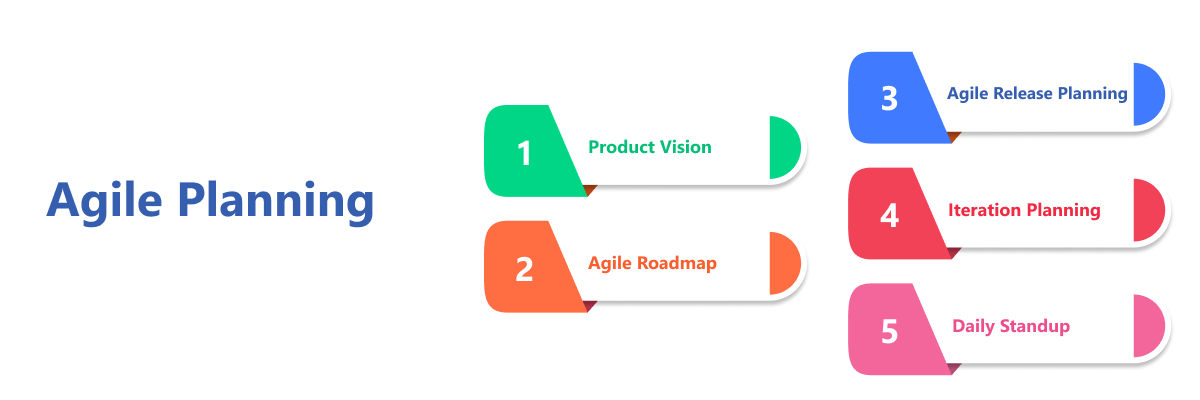Planning is essential for day-to-day life, including work, personal life, and more. Without having a plan, you are subsequently planning to fail.
In software development and releases, without plans, you reach nowhere. Agile methodology is one of the most adapted planning processes in modern days.
Many companies that are thriving to find a way for perfection and improving processes often choose agile planning.
Agile is quickly evolving in workplaces, paving a way to complete work in a complex and ever-changing world.
According to researchgate study, about 71% of the organisation have adopted agile methodology. Reports show that 90% of projects with agile planning produce faster results compared to traditional planning.
In this blog, we’ll show you how to implement the agile methodology for better results.
What is Agile Project Management?

The history of agile planning can be traced back to 1940, originating from Toyota’s lean manufacturing concept. The modern agile methodology was officially launched in 2001.
The 17 software technologists drafted an agile manifesto for the software development process in 2001.
The traditional planning process includes a project plan, identifying a solution, building, testing, producing, and after fixing the problem arising. This method is known as waterfall. It is based on budget and not allowing the alteration or changes after starting.
But Agile methodology is an iterative approach for managing software development projects. Following the principles in the manifesto, the software development team will develop software in small rapid cycles called sprints or iteration. Due to the presence of sprints, the changes or alterations can be easily adopted after the initial start.
A sprint is usually 1-3 weeks, in which a complete development cycle will be done, including design, coding, testing, and release. Agile planning is more effective for working and developing software with updates.
In agile project management, you make detailed plans for shorter time frames, and easily make changes when needed in the project life cycle.
To develop a better mobile or web app, the agile manifesto has four fundamental principles. They are:
-
-
- Individuals and interactions, over processes and tools.
- Working software over comprehensive documentation.
- Customer collaboration over contract negotiation.
- Responding to change over following a plan.
-
The projects adopting agile software development management often results in:
-
-
- Increased speed of development.
- Developed collaboration.
- Minimise waste.
- Increase transparency.
- Enhanced ability to provide better response to evolving trends.
- Fast addressing of customers’ ever-changing needs.
-
Agile Frameworks
There are,presently, more than 50 frameworks available in agile methodology.
You can choose a framework that is more convenient for implementation and appropriate for problem-solving according to your project.
Some of the most used and popular agile frameworks are:
Scrum
A simple framework that promotes team collaboration on complex software projects.
Kanban
Encourages constant collaboration and supports active ongoing learning and improvement.
Extreme Programming (XP)
It involves your customer, gathering feedback quickly, constant testing, and continuous planning. XP Focuses more on technical aspects of software development.
Dynamic Systems Development Method (DSDM)
Provides a foundation for planning, managing, and executing the agile process.
Feature Driven Development (FDD)
It’s a good solution to manage control over incremental and complex agile projects.
Advantages of Agile Project Management
Agile planning has an iterative and incremental approach to project management, which helps in improving modern projects based on their demands. This leads to a good number of advantages while using the agile methodology.
-
-
- High-quality product by applying regular feedback.
- Lessens technical debt by minimisation of resources.
- Enhanced adaptability.
- Continuous improvement.
- Testing based on user experience.
- Decreases risks.
- Improved customer satisfaction.
- Data-driven decision making.
- Improves time to market.
- Early and predictable delivery.
- Excellent project control.
-
Read more about the advantages of agile methodologies.
Planning Steps in Agile Methodology

Agile itself proposes five levels of the planning process for better implementation of agile methodology.
-
-
- Product vision
- Agile roadmap
- Agile release planning
- Iteration planning
- Daily standup
-
1. Product Vision
Production vision is the first step of agile planning. Product vision includes long-term goals, which ensures all the team included in the project have a clear vision of the end product.
By explaining the vision, after every sprint, you can evaluate whether they’re going in the proper direction or not. Also, it helps all the team members to achieve the desired end product successfully.
So have a big picture of your product and define a vision.
2. Roadmap
Planning the roadmap is the second step. In this step, you will plan a roadmap that has milestones to be reached leading us to the end goal. The roadmap is a way to achieve product vision.
In agile planning, the roadmap provides strategies that provide crucial context for the team’s everyday work with the end product.
3. Agile Release Planning
Release plan stands in the third step. The release plan shows how much functionality can be done and how much time is needed to develop.
While framing the release plan you will determine the desired development of the project in each sprint.
4. Iteration Planning
As mentioned earlier, iteration or sprints are small cycles consisting of a duration of 1-4 weeks. Iteration or sprint planning stands at the fourth step.
Before starting a sprint, team members along with the stakeholders will hold a sprint planning meeting. This meeting provides the following information:
-
-
- How much work will be completed at the end of the sprint cycle.
- Access the task load.
- Amount of work for every individual.
-
5. Daily Stand-ups
The daily stand-up is the last stage of agile planning. It includes meeting the team members, either at the start of the day or at the end of the day.
Daily stand-up includes a proper discussion of the works that were completed the previous day and the works that need to be accomplished today.
It shows how much work has been completed, and also shows how to speed up the daily work to complete the project before its deadline.
These five levels help in the proper planning of your software project.
6 Important Features for Enhanced Agile Implementation
To improve the agile management process, we need to focus on the following aspects.
1. Flow Efficiency
Agile project implementation will be successful when there is a proper flow efficiency.
Rather than focusing on capacity utilisation like the traditional management process, agile concentrates on flow efficiency. By following this, we can simultaneously reduce resource waste to deliver the product faster to the market with the desired quality.
The best way to optimise the flow efficiency is swarming. Swarming means when a team member completes a work rather than moving to the next work he will help the colleagues.
Swarming provides a collaborative environment to meet the project goal rather than focusing on individual improvement.
2. Manage Queue Size
In the traditional process, we focus mainly on timelines. In agile, we focus on the queue size.
Queue in software development is the “List of features needs to be developed or the works need to be completed”.
In agile management, the project managers focus on queue size to reduce cycle time and increase the efficiency of the project management process.
Shorter queue sizes have the advantage of reducing the time to deliver, easy inclusion of new changes to the development process, and more.
Read on to know how to manage risk in software development.
3. Decreased Batch Size
Decreasing the batch size will reduce the overall risk. The little batches of work will result in smoother workflow, with reduced variability, resulting in quicker feedback loops.
4. Adding “Work in Progress” Constraint
Adding the work in progress (WIP) will result in effective management of queues. WIP shows the number of tasks the team works on at the current time.
Many works in progress at a time will lead to regular context switching, increased risk of rework, and produces overall waste in the process.
So managing the WIP in agile management will result in proper queue management and enhanced flow efficiency.
5. Combine Fast Feedback Loops
Fast feedback loops are one of the important reasons for agile management success. Try to get feedback from customers after every release that will lead to enhanced results.
Sync your feedback with the ongoing works for the development of your product or service in a timely manner.
6. Decentralised Decision-Making
In traditional management, for making every decision, we need to go through many high authority steps.
In agile management, decentralised decision-making gives power to teammates who are really close to the technical details of the work progress to make decisions. Thus reducing time waste and making the team member feel more valuable, and the decision will be reliable to the problem.
Check out the Top 15 Strategies to Quickly Grow Your Company in 2021.
Conclusion
Agile methodology is fast, reliable, and efficient when combined with proper implementation and analysis.
For software development where there are a lot of updates, agile management will result in enhanced results than the traditional management process. Try to understand the needs of your project before selecting the frameworks.
So are you planning to build your new software project? See how you can hire app developers to develop your product successfully.




